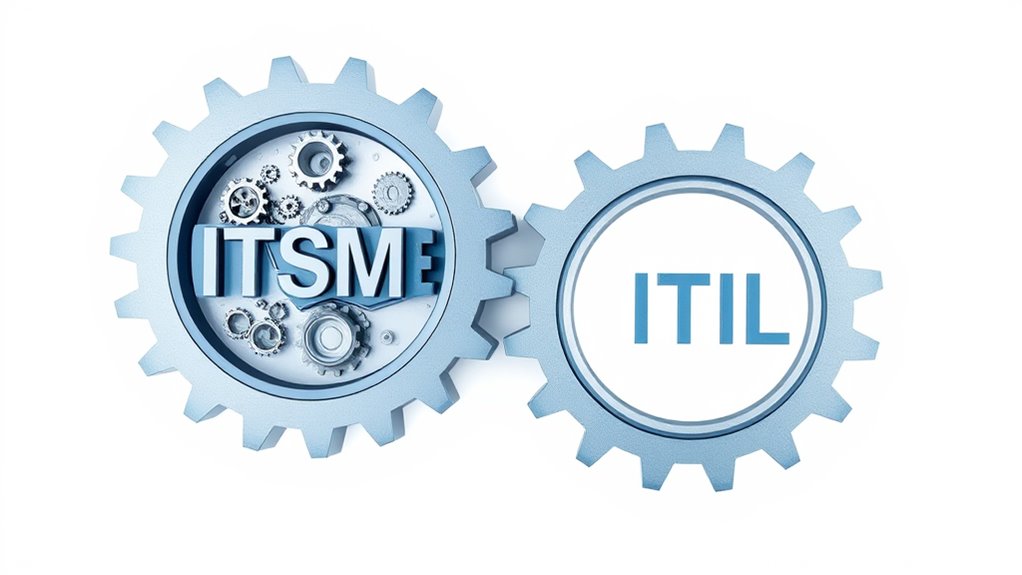ITSM and ITIL serve distinct but complementary roles in IT service delivery. ITSM represents the overall discipline of managing IT services across an organization, encompassing strategy, delivery, and improvement. In contrast, ITIL functions as a specific framework within ITSM, providing detailed guidelines and best practices for implementation. While ITSM establishes the broader strategic direction, ITIL offers tactical procedures and workflows. Understanding these differences helps organizations effectively structure their service management approach and reveal deeper insights into ideal implementation.

The distinction between ITIL and ITSM represents an essential concept in IT service management that often creates confusion among professionals. ITSM encompasses the broader discipline of managing IT services, while ITIL serves as a specific framework within this larger domain. Think of ITSM as the overarching philosophy that guides how organizations deliver and manage their IT services to meet business objectives and create value for stakeholders.
ITSM focuses on the thorough management of IT services, including strategy development, service delivery, and continuous improvement. It addresses the fundamental aspects of aligning IT capabilities with business needs while maintaining strong relationships with stakeholders. Organizations implementing ITSM can choose from various frameworks, including COBIT, ISO/IEC 20000, and ITIL, with ITIL being the most widely adopted option. Modern organizations often leverage ITSM tools like ServiceNow to automate and streamline their service management processes. Axelos maintains and owns the ITIL framework, ensuring its continued evolution and relevance in the industry. Effective incident management features are essential components of modern ITSM solutions that help organizations maintain service quality.
ITSM represents a comprehensive approach to managing IT services, ensuring that technology solutions align perfectly with an organization’s strategic goals and stakeholder expectations.
ITIL provides detailed, prescriptive guidance for implementing ITSM effectively. It breaks down service management into five distinct lifecycle stages: Service Strategy, Service Design, Service Transition, Service Operation, and Continual Service Improvement. Each stage contains specific processes and procedures that organizations can follow to standardize their IT service management practices and improve service quality.
The relationship between ITIL and ITSM is best understood as ITIL being a tactical tool within the strategic framework of ITSM. While ITSM establishes the overall direction and governance structure, ITIL offers concrete steps and best practices for executing that strategy. For example, when managing incidents, ITSM defines the high-level requirements and objectives, while ITIL specifies the exact procedures, roles, and workflows needed to handle incidents effectively.
Organizations typically adopt ITSM as their thorough approach to IT service management and may implement ITIL alongside other frameworks to achieve their objectives. This flexibility allows businesses to tailor their service management approach to their specific needs while maintaining alignment with industry best practices.
The key is understanding that ITIL serves as one of several possible paths to implementing effective ITSM practices.
Frequently Asked Questions
How Long Does It Take to Implement ITIL in an Organization?
ITIL implementation typically takes 12-24 months for a complete organizational rollout. The timeline consists of several phases: assessment and planning (2-3 months), training and knowledge development (3-4 months), process design and documentation (4-6 months), and implementation with continuous monitoring (6-12 months).
Factors affecting duration include organizational size, complexity, resource availability, and stakeholder commitment levels throughout the transformation process.
What Certification Should I Get First: ITIL or ITSM?
Based on industry standards and career progression paths, professionals should start with ITIL Foundation certification.
This entry-level certification provides essential knowledge of IT service management concepts and creates a solid foundation for advanced learning.
After mastering ITIL Foundation principles, individuals can then pursue broader ITSM certifications that align with their organization’s specific needs and frameworks.
ITIL Foundation serves as a stepping stone for more complex ITSM certifications.
Can Small Businesses Benefit From Implementing ITSM Practices?
Small businesses can greatly benefit from ITSM practices through several key advantages.
ITSM implementation reduces IT operational costs by up to 20% while improving business efficiency by 35%. The framework helps standardize IT processes, enhance security measures, and streamline service delivery.
Benefits include better incident resolution times, improved customer satisfaction rates, and enhanced compliance management.
For SMEs, ITSM provides structured approaches to manage IT resources effectively despite limited budgets.
Which Framework Is More Cost-Effective for Startups: ITIL or ITSM?
ITSM frameworks typically prove more cost-effective for startups due to their flexible pricing models and scalable implementation options.
While ITIL requires significant upfront investment in training, certification, and process development, ITSM solutions offer pay-as-you-grow models starting at $20-45 per agent monthly.
ITSM’s adaptable nature allows startups to implement essential services immediately while gradually expanding capabilities, avoiding the heavy initial costs associated with full ITIL adoption.
Are There Any Free Tools Available for ITSM Implementation?
Several free ITSM tools are available for organizations seeking cost-effective implementation solutions.
Popular options include Spiceworks, which offers help desk ticketing and inventory management, and OTRS, featuring customizable ticketing and process automation.
Other viable choices are RT (Request Tracker) for bug tracking and workflow management, OSTicket for customer service, and Zammad for multi-channel communication.
These tools provide essential ITSM features without licensing fees, making them particularly suitable for small to medium organizations.









